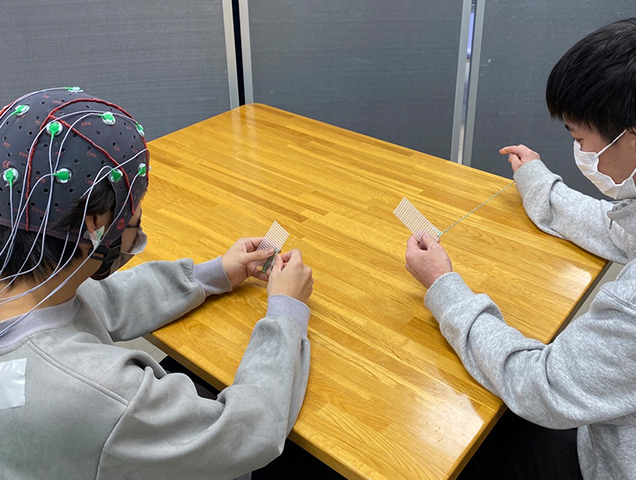Research News
Aug 7, 2023
- Rehabilitation Science
Your presence matters: parallel group craft activities proven effective in occupational therapy
Working independently in a shared space was found to enhance relaxation
Two individuals performing craft activities independently (Parallel condition)
Parasympathetic activity, which indicates relaxation, significantly increases when two individuals engage in separate craft activities compared to when working alone.
Credit: Ryouhei Ishii, Osaka Metropolitan University

Osaka, Japan – “Your presence means the world to me” may sound like a wedding invitation cliché, but an Osaka Metropolitan University study has shown that the presence of others while working does generate a state of relaxation and positive brain activity.
In psychiatry, occupational therapy encompasses not only the individual-therapist relationship but also occupational activities and group work. In clinical practice, having multiple individuals engage in separate activities within the same room has been deemed effective as part of occupational therapy. However, there has been a dearth of clear electrophysiological evidence supporting this approach.
Meanwhile, previous studies have shown that performing craft activities alone can lead to a state of focused attention, as evident from specific brainwave patterns associated with concentration. Individuals exhibiting such brainwave patterns were also found to experience an increase in parasympathetic activity, which predominates in relaxation conditions.
Combining these two aspects, a research team led by Professor Ryouhei Ishii and graduate student Junya Orui, from the Graduate School of Rehabilitation Science at Osaka Metropolitan University, examined the electrophysiological effectiveness of performing craft activities in the presence of others.
The team measured and analyzed brainwaves and autonomic nervous system activity during craft activities in 30 healthy young adults under the following three conditions: an individual performed the craft activity alone (Alone condition); two individuals engaged in separate craft activities independently (Parallel condition); and two individuals participated, during which one individual performed the craft activity while the other observed (Nonparallel condition).
The experiment results revealed that parasympathetic activity was significantly higher in the parallel condition than in the alone condition. Additionally, in all conditions, individuals who exhibited concentration-related brainwave patterns during craft activities showed a significant increase in parasympathetic activity compared to those who did not exhibit such brainwave patterns.
“This study provides electrophysiological evidence that working in the presence of peers and the focus on craft activities can boost parasympathetic activity, even without physical contact or verbal interaction,” stated Mr. Orui. “In the future, we aim to investigate the structures and environments for more effective occupational therapy based on these findings.”
This study was published online in Neuropsychobiology.
Funding
This work was partially supported by the Japan Society for the Promotion of Science (JSPS) KAKENHI Grant No. JP22K11453; however, the funding agency was not involved in the conduct of the research or preparation of the article.
Paper Information
Journal: Neuropsychobiology
Title: Social Buffering Effects during Craft Activities in Parallel Group Session Revealed by EEG Analysis and Parasympathetic Activity
DOI: 10.1159/000531005
Author: Junya Orui, Keigo Shiraiwa, Fumie Tazaki, Takao Inoue, Masaya Ueda, Keita Ueno, Yasuo Naito, Ryouhei Ishii
Publish: July 4, 2023
URL: Neuropsychobiology (KARGER INTERNATIONAL Webpage)
Contact
Graduate School of Rehabilitation Science
Ryouhei Ishii
E-mail: ishii [at] psy.med.osaka-u.ac.jp
*Please change [at] to @.
SDGs
